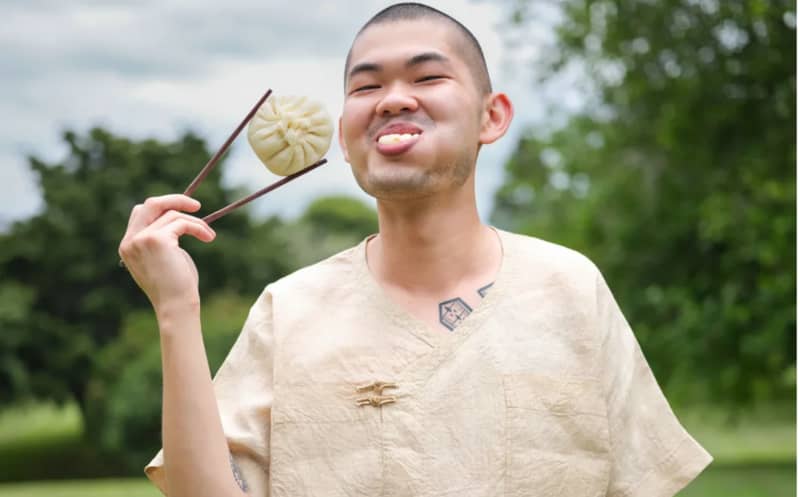The best Chinese vegetarian dishes, recommended by chefs
Popular and delicious dishes like Tomato Egg prove Chinese cuisine isn't always meat-centric, says Auckland chef Sam Low.

While a lot of Chinese cooking features meat, there are also a lot of tasty and easy-to-make vegetarian options that might not be known to many.
Sam Low, who won Masterchef in 2022, said people might think of whole chicken, whole duck or roast pork when they thought about Chinese food, but that was not what the cuisine was all about.
Cold slice noodles with chili oil (liáng pí), tomato egg, tofu and century egg, blanched vegetables with chili oil and different vegetarian dumplings were among its many popular non-meat dishes, he said.
"I guess what we perceive as Chinese food, a lot of it is centred around meat. However, if you look at China as a whole and ... understanding its gastronomy, a lot of it is based around vegetables... and meat is used sparingly to season vegetables."
From left to right: Vegetarian spring rolls, Chinese cucumber salad and Chinese chive omelette.
Supplied
Most of the time, dishes would be made up of stir-fried or blanched vegetables, or steamed tofu and beans, and people would only use a little bit of meat - such as dried shrimp, cured ham or Chinese sausage - to make the vegetables more enticing, Low said.
"Back in [the] old days ... meat was scarce, and being able to use it was a luxury.
"This [sparing use of meat] also helped food go further."
Vegetarians and vegans often looked for dishes that were exciting for the palate, he said.
"We're quite lucky in Auckland where a lot of regional food including from Sichuan, Xi'an and central China is readily available now."
Award-winning chef Sam Low.
Supplied
His all-time favourite vegetarian dish was cold slice noodles with chilli oil, which are often made with mung bean starch and served with slices of cucumber and sweet soy chilli oil. The dish is available at places selling food from Xi'an.
Low said he was also a fan of the Chinese household dish tomato egg.
"Every region has its own version of tomato egg, which is something anyone can make at home with a couple of tomatoes and some eggs.
"It's literally a soft scrambled stir-fried egg, which you cook with diced tomatoes. The dish is then seasoned with ginger, garlic, and salt and sugar. It tastes so delicious with rice."
Vegetarian dumplings were quite common as well, and often those were cooked with a filling of either eggs or vermicelli mushrooms, he said.
For the Lunar New Year, Low's parents, who are from Guangdong in China, cooked some symbolic dishes such as sea moss stewed with shiitake mushrooms.
That particular sea moss "fà cài" (发菜, "fat choy" in Cantonese) is pronounced similarly to the phrase fā cái (发财) which means "making a big fortune".
Low also encouraged people to explore the different flavours and cooking techniques from different places in China to make their own vegetarian food.
"A lot of what makes Chinese food so amazing is the main flavour profiles from each region.
"You've got vinegars, rice wines, and varied steaming techniques. You've got deep frying, stir fry, and wok fry. Then you've got the Sichuan, the spicy, the numbing, but also the nutty and the sweet and garlicky. Then you've also got the spicy, like cumin kind of flavours.
"So even if you take the same vegetable and you use different regional flavourings of China, you would have so many exciting dishes."
Joyve Cafe's vegetarian dishes, including mapo tofu, cucumber salad, seaweed salad, and dumplings.
Supplied
Daqing Li is the owner and chef of vegetarian restaurant Joyve Cafe in central Auckland.
Hand-pulled vegetarian noodles and a diverse range of vegetarian dumplings were the most popular dishes among guests, he said.
"Our handmade dumplings have a lot of different fillings including fennel, shepherd's purse, Chinese cabbage, shiitake mushroom."
The food served in his restaurant did not contain spring onion, onion, garlic, or garlic chives as those were believed to fuel people's desires and tempers, he added.
"Eating vegetarian food is good for our physical and spiritual health," Li, who turned vegetarian a decade ago, said.
Joyve Cafe in Auckland serves vegetarian Peking duck (top right), a cucumber salad (bottom right) and turnip cake (middle).
Supplied
Li first started on the diet for health reasons. His convictions became stronger when he became aware of animal cruelty, and his religious belief also aided the desire to continue vegetarianism when he started following Buddhism.
Detailing a simple vegetarian dish people can make at home, Li suggested making a fennel and tofu filling for dumplings, as making dumplings was an essential family activity for the Lunar New Year for many Chinese.
"Just mix fennel and tofu together, then add only a little bit of soy sauce and sesame oil. You should not add any salt and keep it light," he said.
"Fennel has a strong taste, so eat [the freshly made dumplings] with a dipping sauce made from a little bit of vinegar, soy sauce and sesame oil, and it will be very tasty."
Sign up for RNZ's daily newsletter
HelpNgā Pitopito Kōrero, is a curated by our editors and delivered straight to your inbox every weekday.